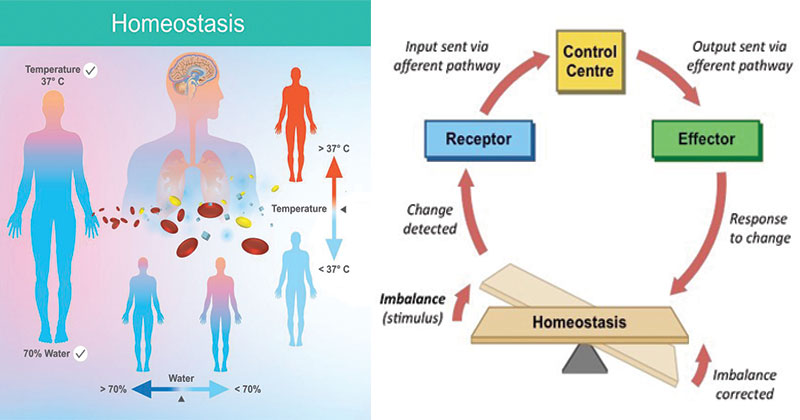Compiled by Hafsat Yusuf Adam
Homeostasis is referred to the protection of the internal environment from the harms of fluctuations in the external environment. It also keeps the internal fluctuations in a narrow range with various control systems compared to wider external fluctuations. If homeostasis is successful, life continues, if unsuccessful, disaster or death ensues. The stability attained is a dynamic equilibrium, in which continuous change occurs, yet relatively uniform conditions prevail.
There are parts involved in homeostasis which are:
(i) kidneys. (ii) liver. (iii) skin. (iv) ductless glands. (v)brain.
Kidneys: are a pair of bean-shaped organs present in all vertebrates. They remove waste products from the body, maintain balanced electrolyte levels, and regulate blood pressure.
Functions;
I) Osmoregulation is the mechanism of regulation, generally between organisms and their environment, of solute and the gain and loss of water.
II) Excretion: the elimination of nitrogenous wastes.
III) Thermoregulation is designated as the maintenance of internal temperature within a tolerable range.
The liver: This is one of the most important organs in the body of a mammal. It is the largest solid organ in the body. Its average weight is about 1•25kg. The liver lies below the diaphragm and is located on the right side of the abdomen. It is dark red.
Functions;
I) Regulation of the blood sugar
II) Detoxification
III) Formation of red blood cells
IV) Production of heparin.
The skin: It is the largest organ of the body made of water, protein, fats, and minerals. It covers the entire surface of the body. And the skin is made up of two types; the epidermis and the dermis.
Functions;
I) Protection: Skin protects the body from germs and regulates body temperature.
II) Sensitivity: Nerves in the skin help you feel sensations like hot and cold.
III) Excretion
IV) Protection of vitamin D.
Ductless glands (Hormones): The endocrine glands do not have ducts to carry their product to a surface so, they are called ductless glands, while hormones are chemical messengers or biochemical substances produced in minute quantities in one part of an organism and transported to the site of action. The endocrine glands are;
I) Pituitary gland:it secrets hormones like; prolactin, oxytocin, and antidiuretic hormone (ADH).
Function: It stimulates and controls milk production by the mammary gland. It promotes the growth of bones and muscles.
II)Adrenal gland: It secrets the hormone adrenaline,
Function: It increases heartbeat and respiration.
III)Stomach: It secrets the hormone gastrin,
Function: It activates the gastric glands to produce gastric juice.
The brain is a complex organ that controls thought, memory, emotion, touch, motor skills, vision, breathing, temperature, hunger, and every process that regulates our body. Together the brain and spinal cord that extends from it make up the central nervous system (CNS).
And also the peripheral nervous system (PNS) consists of the rest of the nerve tissues found throughout the body.
So, as we can see, all these parts involved in homeostasis mentioned above are maintenance of a fairly constant internal environment of an organism, and also the brain has the overall control of the homeostasis process in the body.
Hafsat Yusuf Adam is of Kano Capital Girls Secondary School, Kano.







